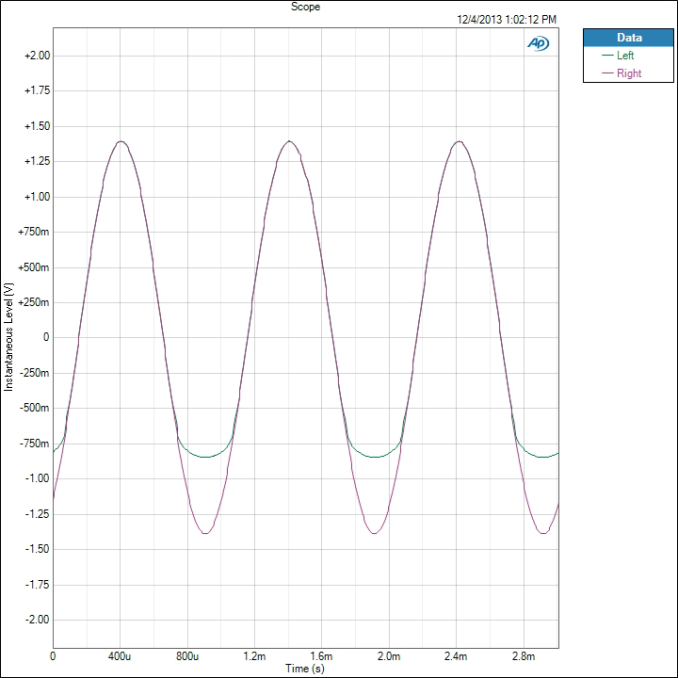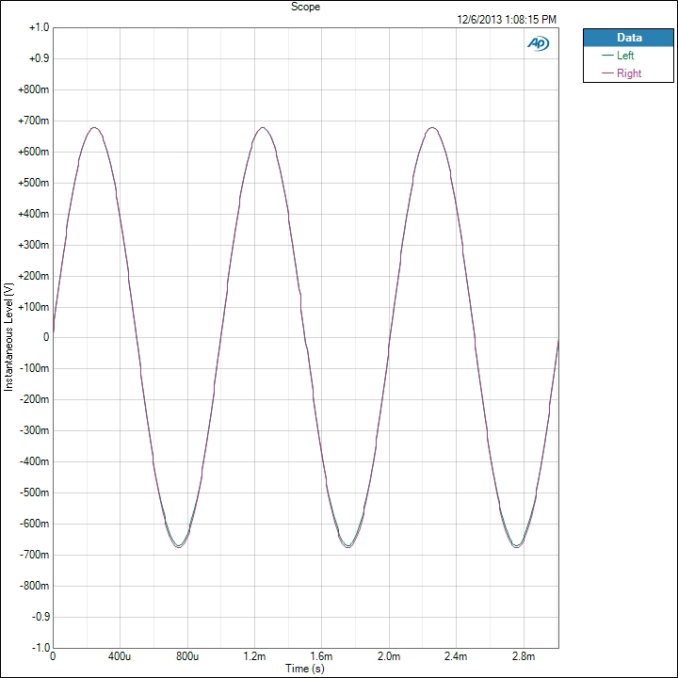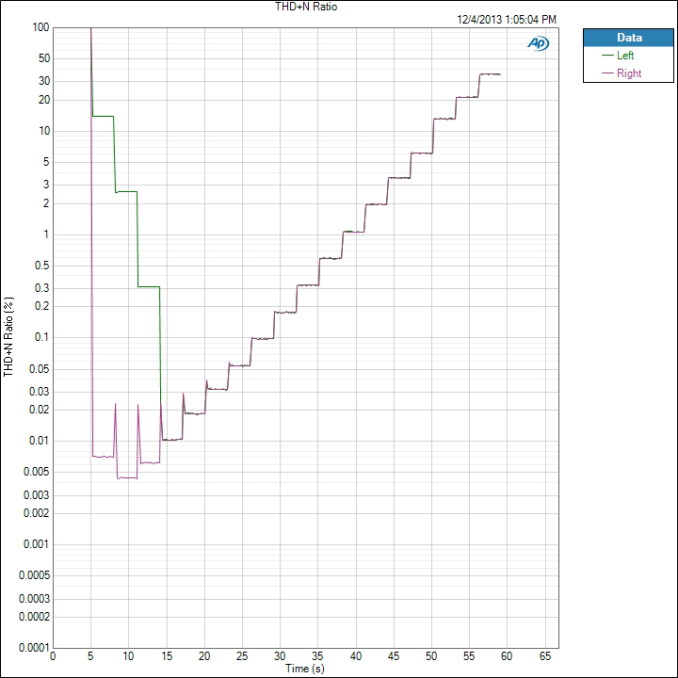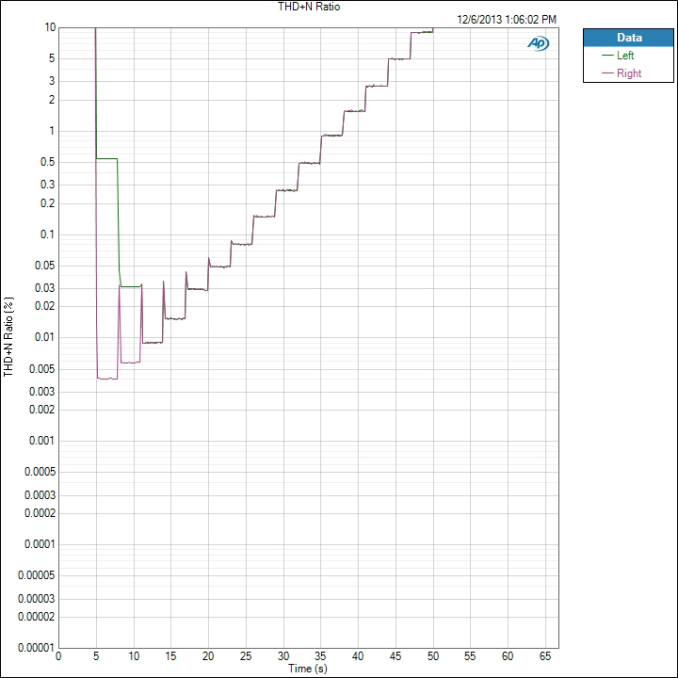Smartphone Audio Quality Testing
by Chris Heinonen on December 8, 2013 5:15 PM EST- Posted in
- Smartphones
- Audio
- Mobile
- Tablets
- Testing
In many of the examples you have seen so far, you notice that the Nexus 5 has a large issue with the left channel at peak volume levels. As Brian mentions in his Nexus 5 review, it is based on a similar platform to the LG G2 but it isn't identical. Because there are similarities I want to test it out and see if it has the same issue that I see on the Nexus 5.
The test that is causing the large issue on the Nexus 5 is a 1 kHz sine wave, at -0dBFS, at maximum volume. This is the loudest sound that any device will be asked to produce. If you're familiar with the trends in music mixing the past two decades you'll know that a peak of -0dBFS is not all that uncommon now. This chart at NPR shows the average and peak levels for the most popular songs over the past thirty years. Two decades ago testing for -0dBFS might not have been important but it is now. So lets look at this image from the Nexus 5 again.
Now for comparison, we will look at the LG G2.
This looks much better. However the LG G2 is still putting out 0.546528% THD+N into the left channel while only outputting 0.003338% into the right channel. So there is still some imbalance going on here. So why is the issue so much less on the G2 than on the Nexus 5?
The key to this is looking at the scale on the graphs here. While the Nexus 5 peaks are up close to 1.3-1.4V, the G2 has peaks that don't even reach 700mV. Looking at the actual numbers the G2 has a Vrms level of 475.3 mVrms while the Nexus 5 checks in at 843.6 mVrms for the left channel and 982 mVrms for the right channel. The G2 is placing far less stress on its headphone amplifier and keeping it from the output levels that cause this excessive clipping in the Nexus 5.
To look in more detail, we have THD+N Ratio charts for the stepped level sweep that we looked at earlier. First, lets look at the Nexus 5.
We see that the first three volume levels, 15-13, have THD+N distortion over 0.3% for the left ear, while they are below 0.01% for the right ear. From level 12 and below the THD+N levels are practically equal. Now to see how this data on the G2 looks.
We see the first volume step has 0.55% THD+N or so for the left ear, but the right ear is down at a similar level to level 14 on the Nexus 5. The next step drops it to 0.03% which is way, way below where it is on the Nexus 5 at that point. By step 13 they are equal.
The conclusion I pull from this is that both the G2 and the Nexus 5 have the exact same flaw right now. However, the G2 has attempted to hide it by reducing the maximum output level of their headphone amplifier. The Nexus 5 can play louder, but only with far more distortion. Given this I would expect there to be an update to the Nexus 5 at some point that lowers the maximum headphone level to something closer to the G2.
However this doesn't mean that the Nexus 5 is certainly worse to use with headphones. The top 3 settings are ones I would avoid due to the left channel issue, but I might avoid the top 1-2 settings on the G2 as well. If we consider 1% THD+N to be the maximum allowable level, that leaves 8 volume steps on the Nexus 5 that are usable. The G2 has 9 steps that are available to you, and 10 if you consider 0.03% THD+N in one ear to be OK (it probably is).
In the end, the G2 won't play as loud as the Nexus 5 will, but you don't want to play that loud anyway. It has more usable volume steps than the Nexus 5, and otherwise very similar numbers. I'll be interested to see if either of them make further changes to their maximum output levels to remove this issue.














188 Comments
View All Comments
lmcd - Sunday, December 8, 2013 - link
Only Anandtech :-)Curious to see how (badly) the S3 fares.
Old_Fogie_Late_Bloomer - Sunday, December 8, 2013 - link
Even with the occasional stinker of an article (yay, non-removable batteries...?), I have to say......it's stuff like this that keeps me coming back to the site. Only Anandtech, indeed. :) Keep up the quirky, in-depth work.
althaz - Sunday, December 8, 2013 - link
I don't know about the S3, but the S2 was rated very highly for audio quality.quick brown fox - Sunday, December 8, 2013 - link
I believe it was the opposite; S3 was lauded due to its wolfson dac (as well as the original Galaxy S), while S2 was condemned for not using that same DAC.Hopefully all gets measured so we can have some objectivity involved.
MadMan007 - Sunday, December 8, 2013 - link
Yeah but talking about a specific DAC chip is audio nerds looking at just a piece of the equation and using it as a potential red herring. The analog amplifiers and output, and overall implementation, matter much more than which specific DAC chip is used as long as it's not garbage, meaning basically any modern DAC chip.krazyfrog - Monday, December 9, 2013 - link
AnandTech actually tested the audio of the international Galaxy S II in their review and found it to be quite poor.zShowtimez - Monday, December 9, 2013 - link
After just moving from a S2 to a HTC One, let me tell you how awful the S2 was...Samus - Monday, December 9, 2013 - link
The surface(s) all use a wolfson dac and sound fantastic, too. The implementation means nothing if your base source is some realtek crap.Hemlocke - Sunday, December 8, 2013 - link
The i9100 had the Wolfson DAC, but the U.S. Variants didn't.onslaught86 - Sunday, December 8, 2013 - link
The i9100 did not have a Wolfson DAC. The i9300 did, while its US variants did not. And boy was it night & day coming from the i9100.